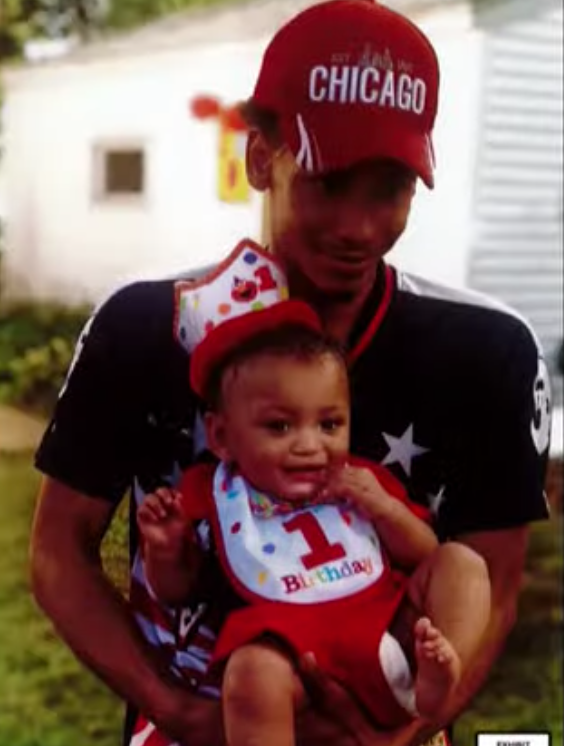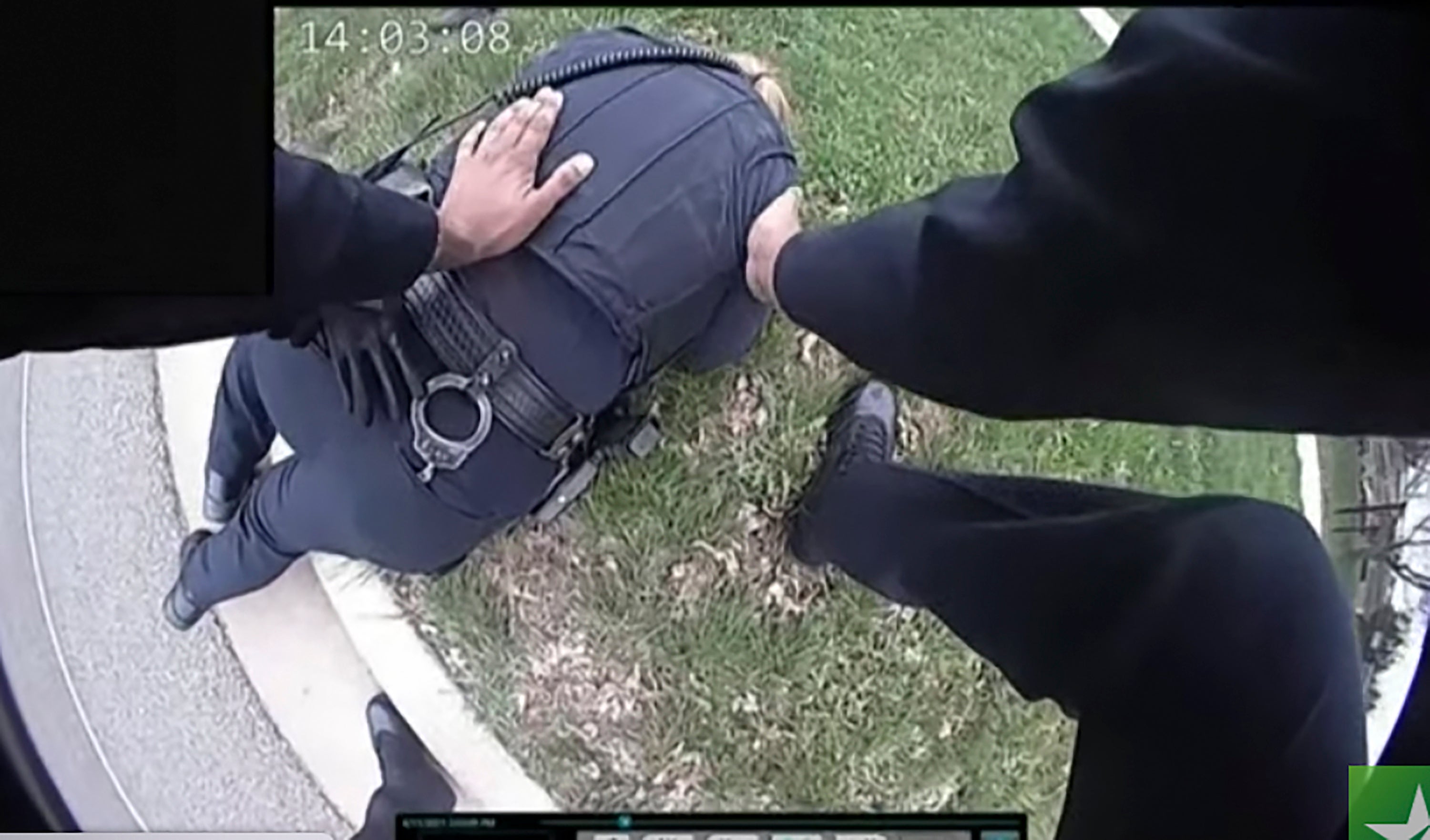
Long before the manslaughter trial of Kim Potter began, comparisons were being drawn with the murder trial of Derek Chauvin just eight months earlier.
In both cases, veteran white police officers killed Black men during deadly arrests in Minnesota.
The arrests both began over minor incidents - a $20 counterfeit bill in one and expired licence plate tags and an air freshener in the other.
George Floyd was killed by Chauvin’s knee and Daunte Wright was killed by Potter’s firearm.
The two men’s deaths sparked protests across the state, the US and the globe calling for racial justice and an end to police brutality against Black people.
And now, both officers have been found guilty over their killings.
On 23 December, Potter was found guilty of first degree and second degree manslaughter after she shot dead Mr Wright back in April when she pulled him over for a traffic stop. She was sentenced to 24 months on 18 February.
The Brooklyn Center police officer of 26 years said she mistakenly pulled her firearm instead of her taser, firing one fatal shot that cut the young father-of-one’s life short.
Chauvin, meanwhile, was found guilty of Mr Floyd’s murder after the officer of 18 years knelt on the Black man’s neck for more than nine minutes as he desperately gasped for air, telling him “I can’t breathe”.
From the killings and the footage of the incidents, to the courtroom drama and convictions, several parallels can be seen between the two cases.
The killings
Parallels have been drawn between the two cases ever since Mr Wright was shot dead back on 11 April.
At the exact moment the 20-year-old was killed, Chauvin’s trial was underway just 10 miles away in Hennepin County Courthouse.
Tensions were already at boiling point in Minnesota due to Chauvin’s trial as Mr Floyd’s murder on Memorial Day 2020 marked the latest in a long line of police killings of Black people in America and fuelled months of Black Lives Matter protests.
Ahead of the trial, security was ramped up in Minneapolis, businesses boarded up and Hennepin County Courthouse became a fortress with metal fencing erected around it.
Protests erupted in the city once again following Mr Wright’s death and Ben Crump, a prominent civil rights attorney representing both the families of Mr Floyd and Mr Wright, described his killing as an “execution”.
Nine days after Mr Wright was shot and killed, jurors returned their verdict in Chauvin’s case, finding him guilty of all charges.
Now, after 27 hours of deliberations, the jury in Potter’s case found her guilty of both manslaughter charges.

The opening statements
In opening statements earlier this month, prosecutors said former police officer Potter “betrayed the badge” when she shot and killed the Black man while the defence blamed Mr Wright for failing to comply with the commands of law enforcement – setting up the opposing version of events that jurors can expect to hear over the coming weeks.
Prosecutor Erin Elridge argued that, as a longstanding police officer, Potter was trained to deal with such situations and had gone through extensive training in the risks of using the wrong weapon over the years.
When she pulled her weapon and shot Mr Wright, she violated this training and her oath “to protect life, not to take life”.
She “betrayed a 20-year-old kid”, Ms Elridge said.
“This is exactly what she had been trained for years to prevent. But on April 11, she betrayed her badge and she failed Daunte Wright,” she said.
“We trust them to know wrong from right, and left from right.
“This case is about an officer who knew not to get it dead wrong, but she failed to get it right.”

In the opening statement for the defence, attorney Paul Engh instead argued that Potter is “human” and made the “mistake” in the heat of the moment of the situation.
“We are in a human business. Police officers are human beings. And that’s what occurred,” said Mr Engh.
He also sought to shift the blame onto Mr Wright for his death – saying he would still be alive if he had followed the officer’s commands.
“All he has to do is stop and he’d be with us,” he said, adding all Mr Wright “had to do was surrender”.
Mr Engh also said Potter was trying to save the life of her colleague who he said could have been injured as Mr Wright attempted to flee. He claimed the officer was right to be concerned that Mr Wright may be armed due to an outstanding warrant on a firearms charge.
Both the prosecution and the defence set the stage for similar lines of argument to those heard during Chauvin’s trial.
In fact, Ms Elridge’s language was almost identical to that used by Assistant Attorney General Jerry Blackwell during the state’s opening arguments in that case back in March.

“You will learn that on May 25 2020 Mr Derek Chauvin betrayed his badge when he used excessive and unreasonable force upon the body of Mr George Floyd,” he said.
During the murder trial, prosecutors also argued that Chauvin violated his training, with the court hearing from state witnesses how the experienced officer was trained to “stay away from the neck when possible” when restraining a suspect.
Meanwhile, Chauvin’s defence attorney Eric Nelson had put forward a similar argument in his opening argument that his client gave a human response to the situation.
He argued that the officer had more to deal with than only Mr Floyd as a large crowd gathered around the incident.
And the defence similarly tried to pin the blame for the tragedy on the victim, arguing that Chauvin had no choice but to use force because Mr Floyd’s refusal to get in the police car was a form of resisting arrest.

The similarities continued to run throughout Potter’s trial.
During closing arguments, the prosecutor told jurors that Mr Wright’s death was “avoidable” and that “carrying a badge and a gun is not a licence to kill”.
“She drew a deadly weapon, she aimed it and pointed it at Daunte Wright’s chest and she fired,” she said.
“She used deadly force, she put a bullet through his heart, she killed him.”
Mr Gray responded in closing arguments by saying it was “absurd” to say that Mr Wright had nothing to do with his own death.
“The causation was Daunte Wright,” he said, arguing that his client had the right to use deadly force in the situation.
“Nobody’s perfect. Everyone makes mistakes,” he said.
The legal teams
Several familiar faces from Chauvin’s trial returned to the Hennepin County Courthouse for Potter’s trial.
Minnesota’s assistant attorney general Ms Eldridge lead the state’s case against Potter and was also a presenting attorney in Chauvin’s murder trial.
Other members of the prosecution’s team included Matthew Frank and Joshua Larson who both also worked on Chauvin’s case.

For the defence, Potter was represented by attorney Earl Gray, who is also representing Thomas Lane – one of the three other police officers still awaiting trial together on charges in Mr Floyd’s death.
Mr Gray and his co-counsel Paul Engh both worked on the legal team for another Minnesota police officer charged in the killing of another Black man, Philando Castile.
St Anthony police officer Jeronimo Yanez was charged with second-degree manslaughter and dangerous discharge of a firearm after he shot dead Mr Castile during a traffic stop in Falcon Heights, Minnesota, in 2016.
He was found not guilty on all charges.
The role of video
Bystander video of Mr Floyd desperately crying out “I can’t breathe” as he lay dying under Chauvin’s neck sent shockwaves across the globe and became a critical part of the trial of the officer.
As the state rested its case, prosecutors simply told the jury: “You can believe your eyes.”
Video once again played a pivotal role in Potter’s manslaughter trial as the shooting and the events leading up to it were captured on the body cameras of both the officer and her colleagues – Officer Anthony Luckey and Sergeant Mychal Johnson.

In the bodycam footage, Potter is heard shouting “taser, taser, taser” before she shot Mr Wright.
She is then heard realising she has used her firearm instead of her taser: “I just shot him. I grabbed the wrong f***ing gun. I shot him, oh my god.”
The footage also shows the officer slumped face down on the grass after the incident.
In closing arguments, prosecutors played slowed-down footage from Potter’s bodycam showing she had her weapon drawn for around six seconds before she pulled the trigger.
The convictions
Both officers were found guilty on all charges at their trials.
However, the charges were markedly different.
Potter was convicted of first-degree manslaughter and second-degree manslaughter.
Chauvin was convicted of second-degree murder, third-degree murder and second-degree manslaughter and was sentenced to 22.5 years in prison.
He also pleaded guilty in December to federal charges that he willfully deprived Mr Floyd of his rights, with his sentencing yet to be scheduled.

In the Potter case, the more serious charge of first-degree manslaughter carries a maximum sentence of 15 years in prison while second-degree manslaughter carries a maximum sentence of 10 years.
However, under Minnesota law, people with no prior criminal record – like Potter – typically receive far lower than the maximum sentences.
Sentencing guidelines recommend between 6 and 8.5 years in prison for first-degree manslaughter and between 3.5 to nearly 5 years for second-degree manslaughter.
Prosecutors ultimately requested that Potter serve the presumptive sentence of 86 months in prison, while the defence asked that she only receive probation.
A judge handed down a reduced sentence of 24 months - 16 in prison and the rest under supervised release - at her sentencing hearing on 18 February after Potter spoke in court to apologise to Wright’s family.
What differences were there?
Unlike Chauvin who did not take the stand, Potter chose to testify at her trial.
She was the last witness called for the defence before closing arguments began and gave emotional testimony, breaking down in tears and putting her head in her hands as she apologised for what happened on 11 April.
“I’m sorry it happened. I’m sorry,” she wailed.
When prosecutors pressed her about whether she had intended to use deadly force that day, she cried out: “I didn’t want to hurt anybody!”
The 49-year-old told the court she was “very distraught” and couldn’t remember much about the moments following the shooting.
“I was very distraught, I just shot somebody. I’ve never done that,” she said.
During her testimony, Potter didn’t call the man she shot dead by his name, referring to him only as “the driver”.







